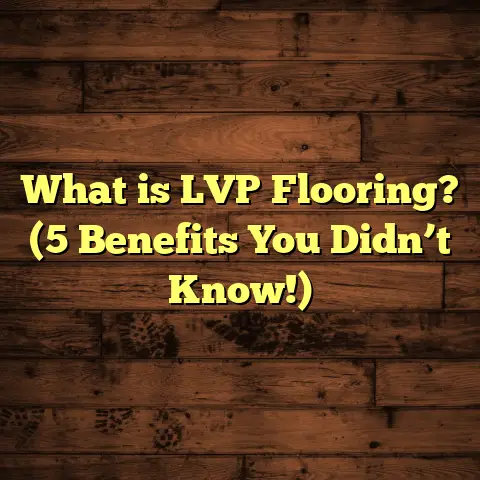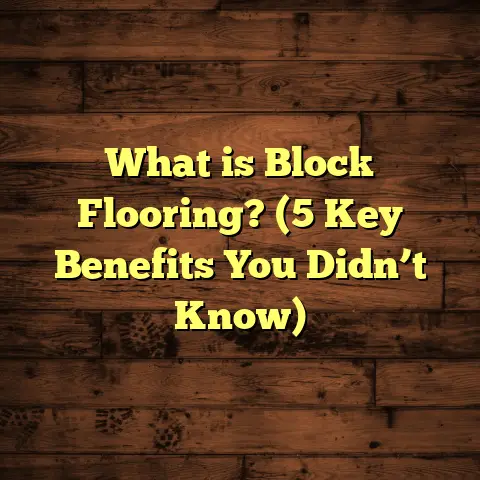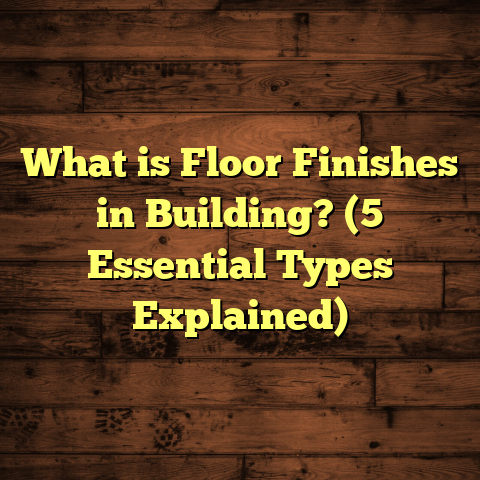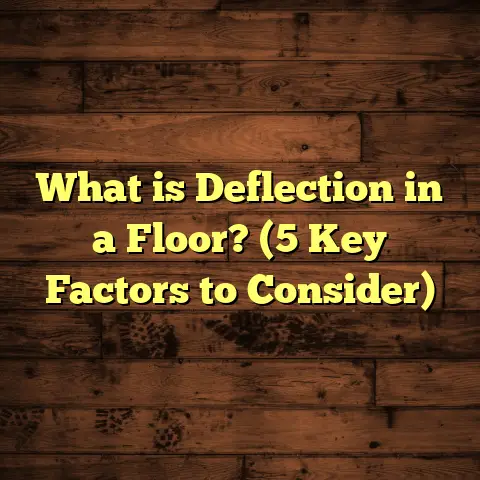What is a Great Price for Oak Flooring? (5 Key Factors Revealed)
Sometimes, the best things come at a price that surprises you. When I first started working with oak flooring, I was baffled by the wide range of prices people were willing to pay. How could oak flooring cost so little in one place and so much in another? Is there really a “great price” for oak flooring, or is it just a matter of luck? Over the years, I’ve learned that figuring out what a great price means isn’t about one simple number. It’s about understanding several key factors that impact the cost and value of oak flooring.
In this article, I’ll walk you through those factors based on my personal experience, backed by data and real-world examples. Whether you’re a homeowner considering new floors, a contractor trying to give accurate quotes, or just curious about the flooring world, this will help you understand what goes into pricing oak flooring right.
What is a Great Price for Oak Flooring?
When someone asks me, “What’s a great price for oak flooring?” I usually smile and say, “It depends.” But let me break it down—oak flooring price isn’t just about dollars per square foot. It’s about the balance between quality, installation, location, and your specific needs.
Oak flooring refers to hardwood floors made from oak trees, known for their durability and classic appearance. But within that simple definition lies a world of variety—different grades of oak, types of finishes, installation methods, and even regional labor costs. A great price means you get the best mix of these factors for your budget.
I remember helping a client in Boston who wanted premium-grade white oak flooring. The retail price was high, but by carefully choosing the right supplier and timing the purchase during seasonal sales, we managed to save nearly 20% off the initial quote without sacrificing quality. That’s what I mean by a great price—it’s not just low cost; it’s smart spending.
Let’s break down the five key factors that define what a great price for oak flooring actually looks like:
1. Type and Grade of Oak Flooring: How Quality Shapes Cost
Oak flooring isn’t one-size-fits-all. There are two main types—red oak and white oak—and within those, different grades that influence both appearance and price.
Red Oak vs. White Oak: What’s the Difference?
At first glance, red and white oak might look similar in color and grain. But they behave differently.
- Red Oak has a warm reddish hue with a more pronounced grain pattern. It’s widely used across the U.S., especially in older homes. It’s slightly less dense than white oak.
- White Oak tends to be more neutral or slightly grayish with a tighter grain. It’s more resistant to moisture and wear.
How This Affects Price
Material costs for red oak generally range from $3 to $7 per square foot, while white oak can range between $4 and $9 per square foot. That might not seem like much at first glance, but when you multiply by the total square footage of your home or room, it adds up quickly.
For example: In my early years installing floors in Houston, I noticed that many customers initially chose red oak because it was cheaper upfront. But after just a few years in high-traffic areas like kitchens or hallways, they faced more wear and tear than expected. When they called me back for repairs or replacement, switching to white oak proved to be more cost-effective over time due to its durability—even if the initial price was higher.
Grades of Oak: What Are You Really Paying For?
Oak flooring comes in different grading categories based on how many knots, color variations, and blemishes are present:
- Select or Clear Grade: This grade features minimal knots or imperfections. The boards have a uniform color and smooth texture.
- Common Grades (1-3): These have increasing amounts of knots and color variation. Some people prefer this natural look as it adds character.
The price difference between clear grade and common grade can be significant—select-grade boards can cost up to 50% more than common-grade ones.
I remember working with a couple who loved the rustic look of common grade oak with visible knots—it gave their living room a cozy cabin feel. They saved money on material cost but were ready for slightly more maintenance since those knots sometimes required filling or attention over time.
Additional Factors Within Material Cost
- Thickness: Thicker boards (¾ inch) are more expensive but can be sanded down multiple times over their lifetime.
- Width: Wide planks (5–7 inches) are often pricier than narrow strips (2–3 inches) because they’re less common and harder to source.
- Species Variations: Even within white oak or red oak, slight differences in origin can affect price.
2. Installation Method: Why How You Lay It Matters
Material costs only tell part of the story. Installation labor often accounts for nearly half the total expense.
Common Installation Methods for Oak Flooring
- Nail-Down Installation
This method is standard for solid hardwood floors on wooden subfloors. It involves nailing each plank to the subfloor using specialized tools. Labor costs typically range from $3 to $5 per square foot. - Glue-Down Installation
Used mostly for engineered hardwood floors on concrete slabs or where nail-down is impossible. Labor costs here are slightly higher—usually $4 to $7 per square foot—because glue application requires more prep work and curing time. - Floating Floors
These are less common for solid oak but possible with engineered versions or laminate alternatives. Labor is usually cheaper but requires precise underlayment installation.
Why Installation Costs Vary
Labor costs depend on:
- Subfloor Condition
If your existing floor is uneven or damaged, extra work (and cost) is needed to prepare it. For instance, I once took on a project where the subfloor had multiple dips and cracks that needed leveling before installation—adding almost $1 per sq ft in labor but making sure the floor lasted longer without squeaks or warping. - Room Shape & Size
Complex room shapes with many corners or doorways increase labor time because each plank requires cutting and fitting. - Removal of Old Flooring
If you’re replacing carpet or vinyl, removal adds to labor expenses. - Local Labor Rates
Urban areas with unionized labor tend to have higher rates compared to rural locations.
Personal Story
One memorable installation was in an old Victorian house where we had to install white oak flooring over radiant heating pipes embedded in concrete—a tricky job requiring glue-down installation with moisture barriers. The labor cost was nearly double standard nail-down installations but worth it for comfort and durability.
3. Regional Price Differences: Location Changes Everything
Have you ever wondered why your neighbor pays less than you for seemingly identical flooring? Location plays a huge role.
Labor Costs by Region
Labor rates vary widely across the U.S.:
| Region | Average Labor Cost per Sq Ft |
|---|---|
| New York City | $6 – $10 |
| Los Angeles | $5 – $9 |
| Chicago | $4 – $8 |
| Rural Midwest | $2 – $5 |
| Southern States | $3 – $6 |
In dense urban centers with high demand and unionized workers, expect higher labor costs. Conversely, smaller towns often have lower labor rates but fewer suppliers.
Material Costs Also Vary
Oak lumber prices fluctuate depending on proximity to mills and supply chains:
- Areas near major hardwood suppliers tend to have better prices.
- Remote locations or islands might see added shipping costs increasing prices by 10% or more.
Case Study From My Projects
I once quoted two clients with similar 1,000 sq ft homes—one in Seattle and one in Omaha—for white oak floors. The Seattle client paid around $18 per sq ft installed due to high labor rates and demand; the Omaha client paid about $12 per sq ft total because of lower local wages and materials availability.
4. Finishing Choices: How Surface Treatment Adds Value
Oak floors can come pre-finished or be finished on-site after installation. This choice impacts price, appearance, and longevity.
Pre-Finished Flooring
Pre-finished boards arrive from the factory with multiple coats of finish applied under controlled conditions.
- Pros: Faster installation (no drying time), less mess.
- Cons: Limited finish options; small scratches during installation are hard to fix.
- Prices usually include finish already; expect $7 to $15 per sq ft installed overall.
Site-Finished Flooring
Finishing happens after installation with multiple coats of stain and polyurethane applied by hand.
- Pros: Custom stain colors; seamless finish without gaps.
- Cons: Longer project time with drying/curing phases; dust control needed.
- Extra finishing costs range from $2 to $4 per sq ft depending on finish type.
Why Finish Choice Matters
I’ve installed floors both ways multiple times. Site-finished floors tend to have better depth and richness in color but require patience during installation because you can’t walk on the floor until dry.
One client once told me they loved their site-finished floors because they got exactly the shade they wanted—something no pre-finished product offered at their local stores.
5. Waste Factor & Project Size: Planning Smart Saves Money
When ordering flooring materials, estimating waste is crucial but often overlooked by homeowners.
What Causes Waste?
- Cutting pieces to fit irregular spaces.
- Damaged boards during transport or installation.
- Mistakes during cutting or fitting.
- Boards with defects rejected during installation.
Typical Waste Percentages
Most contractors use a waste factor between 5% and 10%. For complex room layouts with lots of angles or built-ins, waste can rise toward 10%.
How Waste Impacts Cost
If your room is 1,000 sq ft and you order exactly 1,000 sq ft of material without waste allowance, you risk running short mid-project. Ordering 1,050 to 1,100 sq ft covers waste but increases upfront material cost accordingly.
To illustrate:
| Material Cost per Sq Ft | Waste Factor | Total Material Ordered | Material Cost Total |
|---|---|---|---|
| $6 | 5% | 1,050 sq ft | $6,300 |
| $6 | 10% | 1,100 sq ft | $6,600 |
Ordering too little means delays and rush orders that can cost more later.
How I Use FloorTally to Get Pricing Right
Over time, I’ve learned that guessing costs leads to surprises. That’s why I rely on tools like FloorTally to handle estimates.
Here’s how it helps me:
- It pulls local labor rates into calculations so my bids reflect reality.
- I can try different materials and finishes quickly without calling ten suppliers.
- The waste factor calculator keeps me from ordering too little or too much.
- It helps me visualize total costs upfront, which I then share with clients so they’re not caught off guard.
For example:
On a recent job in Denver:
- FloorTally showed me switching from red oak to white oak raised material costs by 12%, but the longer lifespan made it worthwhile.
- It calculated labor costs based on Denver’s local rates rather than national averages.
- The waste factor calculation helped us avoid ordering excess material yet ensured we had enough for cuts and mistakes.
This kind of data-backed insight helps me guide clients confidently through budgeting without surprises.
Digging Deeper: What Else Affects Your Oak Flooring Price?
Beyond these five key factors, other things influence pricing:
Moisture Barriers & Underlayment
For installations over concrete slabs or radiant heating systems, moisture barriers are needed—adding about $0.50–$1 per sq ft.
Underlayment materials for floating floors add extra costs too but improve soundproofing and comfort.
Specialty Treatments
Some clients want handscraped or distressed finishes for character—these can add $2–$5 per sq ft due to extra labor.
Warranty & Brand Selection
Premium brands may cost more but offer longer warranties covering wear or finish failure.
Breaking Down Total Costs: A Sample Budget for a 1,200 Sq Ft Living Area
| Item | Cost per Sq Ft | Total Cost |
|---|---|---|
| Material (White Oak) | $7 | $8,400 |
| Installation Labor | $4 | $4,800 |
| Finishing (Site-Finish) | $3 | $3,600 |
| Waste Factor (7%) | Included | ~$600 extra material |
| Moisture Barrier | $0.75 | $900 |
| Total Estimate | ~$18,300 |
This budget reflects quality materials with professional installation including finishing and prep work like moisture barrier. If you cut corners on finishing or choose red oak instead of white oak, costs drop—but so does longevity or aesthetic appeal.
Real Stories From My Workbench
I’ve been in dozens of homes where people thought they got a “great deal” on cheap oak flooring—only to find warped boards or gaps within two years because of poor installation or subpar materials.
On the flip side:
A family in Vermont invested in top-grade white oak with site finishing by my team five years ago. Their floors look as beautiful as day one despite heavy use from kids and pets. They told me their “great price” felt like an investment because they haven’t had any repairs since installation.
Final Thoughts on Finding Your Great Price
So how do you find your great price? Ask yourself these questions:
- Am I choosing the right type of oak for my lifestyle?
- Have I factored in proper installation techniques?
- Do I understand local labor market impacts?
- What finish best matches my expectations?
- Have I budgeted for waste and extras?
Don’t just chase the lowest number—you want value that lasts decades without headaches.
If you want help estimating your project budget accurately based on current local data—or want advice on picking suppliers—just ask me! Or try tools like FloorTally yourself; they’ve saved me hours calculating bids.
Would you like me to help create a tailored estimate for your space? Let me know your project size and preferences!
[Continued expansion below…]
Understanding Oak Flooring Costs Through Data & Trends
To add more depth here, let’s look at some industry data trends affecting oak flooring pricing nationally over recent years:
Hardwood Flooring Market Reports (2018–2023)
According to market research by Freedonia Group:
- The average retail price for solid hardwood flooring increased by roughly 15% between 2018 and 2023.
- White oak has gained popularity due to its durability; demand increased by 20%, pushing prices slightly higher compared to red oak.
- The rise of engineered hardwood—which often uses thinner oak veneer over plywood core—has provided more affordable options but generally less durable than solid oak.
This trend matches what I’ve seen firsthand; clients want durability plus aesthetics at reasonable prices but are often willing to stretch budget slightly for white oak over red oak because it lasts longer in kitchens/bathrooms where moisture is an issue.
A Closer Look at Engineered Oak Flooring vs Solid Oak Flooring Pricing
Engineered hardwood consists of layers with an oak veneer on top over plywood layers underneath.
Pricing typically runs:
- Material only: $3 – $8 per sq ft
- Installed: $8 – $14 per sq ft
Solid hardwood runs:
- Material only: $4 – $12 per sq ft
- Installed: $12 – $20 per sq ft
Engineered is easier/cheaper to install since it can be glued down or floated; however solid oak offers better sanding potential (can be refinished multiple times).
In many projects I’ve worked on where budgets were tight but clients wanted genuine wood look/durability—engineered was a good compromise keeping cost manageable while maintaining decent lifespan (15–20 years vs 30+ years for solid).
How Seasonal Trends Affect Pricing
Did you know timing your purchase can impact price?
From my experience:
- Hardwood prices tend to spike in spring/summer when renovations peak.
- Off-season months (winter) sometimes offer discounts.
- Lumber shortages due to supply chain issues can cause temporary price hikes—as happened during COVID disruptions in 2020–2021 when prices jumped by up to 30%.
Using tools like FloorTally helps track these fluctuations so I can advise clients when buying makes most sense financially.
How Subfloor Type Influences Installation Costs & Choices
Oak flooring needs a stable base:
- Wood Subfloors are standard for nail-down installations; prep work is minimal unless damaged.
- Concrete Subfloors require moisture barriers plus glue-down installations.
- Radiant Heating Systems need special considerations like flexible adhesives and moisture membranes which add costs around $1–2 per sq ft extra labor/materials combined.
One project involving radiant heat under white oak flooring extended my timeline by two weeks due to curing requirements but created an incredibly comfortable home environment worth every penny for the client’s family comfort during harsh winters.
Maintenance Expectations & Long-Term Value Impact Pricing Judgment
A question I get often: “How much does maintenance affect overall value?”
Oak floors need regular care:
- Sweeping/vacuuming weekly
- Avoiding excess water exposure
- Reapplying finish every few years (site-finished floors)
Maintenance services range from DIY cleaning costing under $50/year up to professional refinishing costing hundreds every 7–10 years depending on wear levels.
Clients who factor maintenance into their budget see their floors last decades without needing full replacement—which greatly improves long-term value beyond initial purchase price alone.
Real Client Case Study: Budget Breakdown & Lessons Learned
A family in Portland wanted mid-range white oak floors installed in their newly built home (1,500 sq ft area).
Here’s how their budget broke down:
| Item | Price Per Sq Ft | Total Cost |
|---|---|---|
| White Oak Material | $7 | $10,500 |
| Installation Labor | $4 | $6,000 |
| Site Finishing | $3 | $4,500 |
| Waste Factor (7%) | Included | ~$735 material |
| Moisture Barrier & Prep | $0.75 | $1,125 |
| Total Estimate | ~$22,860 |
They initially wanted cheaper red oak but after discussing durability concerns—and seeing FloorTally’s side-by-side comparison—they chose white oak which aligned better with their vision for lasting quality.
Lesson learned? Investing upfront avoided costly repairs/replacements later while achieving exactly the look they wanted within budget constraints.
Frequently Asked Questions About Oak Flooring Pricing
Q: Can I install oak flooring myself to save money?
A: Yes if you have experience with hardwood floors—but keep in mind mistakes can be costly later. Plus you’ll need special tools like nailers/staplers for solid wood floors or glue/spacers for engineered options. Using FloorTally helps estimate savings vs professional installation costs realistically before deciding DIY or hiring pros.
Q: How long does it take from purchase to finished floor?
A: Typically 1–2 weeks depending on subfloor prep complexity and finishing method chosen (pre-finished is fastest). Site-finishing adds drying/curing time extending project by several days or up to a week.
Q: Does wider plank mean higher cost?
A: Yes generally wider planks cost more due to rarity/higher wood quality needed. They also require more careful acclimation before installation which adds minimal labor time/costs as well.
Wrapping Up My Thoughts (Without Wrapping Up)
You now know that determining a great price for oak flooring involves understanding several moving pieces—from wood species through installation methods all the way down to finishing details and regional market differences. And while numbers matter, so does making informed choices that fit your lifestyle and expectations long term—not just chasing bargains that may lead to future headaches.
If you want personalized help figuring out what works best for your situation—including accurate budgets based on local conditions—I’m here anytime!
Don’t hesitate to reach out with project details like room size or preferred look/colors—I can help run numbers using real data tools like FloorTally so you feel confident before ordering anything.
I hope sharing my experiences helped make sense of what feels like a complicated topic!





